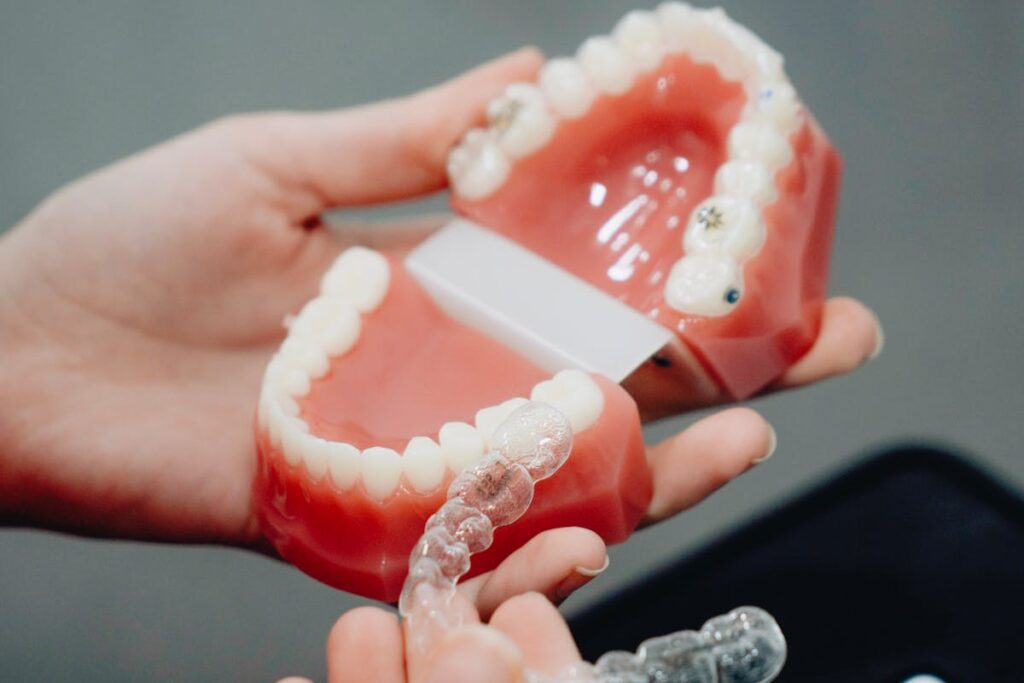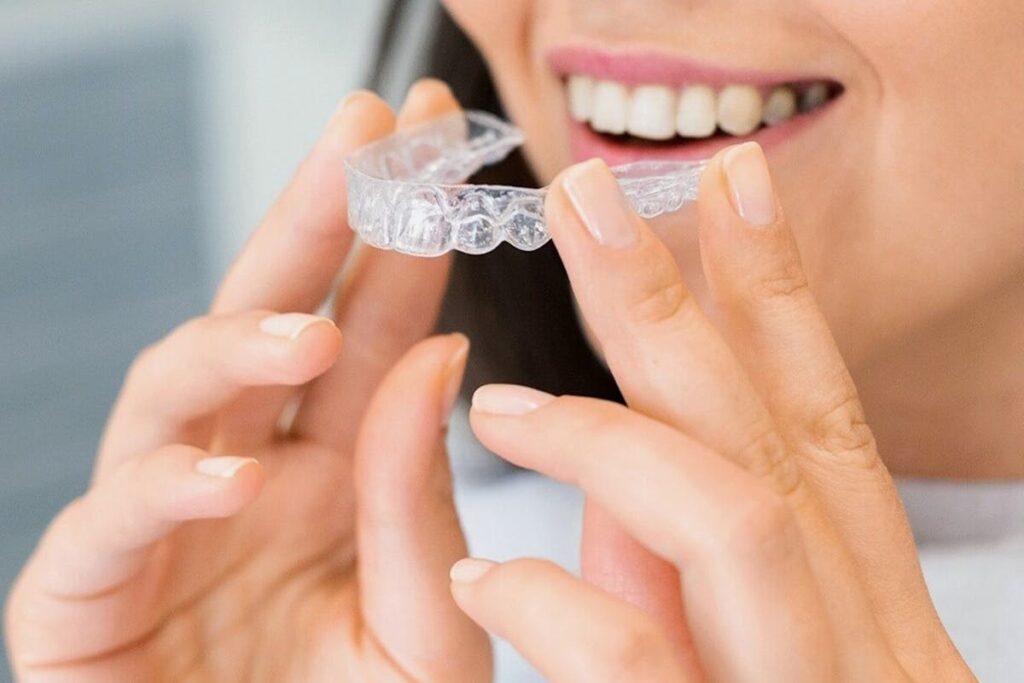Invisalign treatment has revolutionized the world of orthodontics, offering a clear alternative to traditional braces. While its benefits are significant, new users may experience initial discomfort and need to adjust their daily habits. A general dentist has shared practical tips to facilitate this shift. From managing discomfort and maintaining oral hygiene to modifying eating habits and coping with speech changes, these guidelines promise to smooth your Invisalign journey. As you continue, it is intriguing to realize that embracing a new smile might require more than just wearing aligners.
Understanding the Basics of Invisalign
In the domain of orthodontics, Invisalign represents a revolutionary advancement. Unlike traditional braces, Invisalign offers an aesthetically pleasing, more comfortable, and less intrusive alternative for teeth realignment. The treatment involves the use of a series of clear, removable aligners tailored to fit each individual’s teeth perfectly.
The Invisalign timeline can vary considerably depending on the complexity of the case, but the average treatment period usually falls between 12-18 months. Throughout the treatment process, patients are expected to wear the aligners for 20-22 hours a day, only removing them for eating, drinking, and oral hygiene. Each set of aligners is typically worn for two weeks before progressing to the next set in the series.
As for treatment expectations, patients can anticipate gradual movement of their teeth into the desired position over time. Regular check-ups, usually every 6-8 weeks, are essential to monitor progress and make necessary adjustments. The overall goal of Invisalign treatment is not only to improve the appearance of one’s smile but also to enhance oral health by correcting malocclusions which can lead to issues such as gum disease or tooth decay.
Managing Initial Invisalign Discomfort
While the benefits of Invisalign are numerous, it is not uncommon for patients to experience some discomfort during the initial stages of treatment. This discomfort is typically due to the pressure applied by the aligners to shift the teeth into their new positions. To manage this discomfort, several pain relief strategies can be employed.
To begin with, over-the-counter pain relievers such as ibuprofen can be used in moderation to help alleviate any initial discomfort felt. Always make sure to follow the recommended dosage provided by the manufacturer. In addition, using a cold compress on the outside of the mouth for a few minutes at a time can provide temporary pain relief and reduce any swelling that may occur.
Invisalign aligners themselves can sometimes cause irritation to the cheeks and lips, especially in the beginning when you’re getting used to them. To combat this, dental wax can be applied to the edges of the aligners to create a smoother, more comfortable surface.
Daily Maintenance and Cleaning Tips
Ensuring the cleanliness of your Invisalign aligners is a vital aspect of your daily routine. Proper Invisalign care involves daily cleaning of your aligners to remove plaque and prevent discoloration. Start by rinsing your aligners every time you remove them to wash away dry saliva and plaque that can cause bacteria buildup.
When you’re not wearing the aligners, proper aligner storage is necessary to avoid damage and maintain hygiene. Always store your aligners in the case provided by your dentist; never leave them out in the open or wrap them in tissues as they could get lost or accidentally thrown away.
For deep cleaning, use a soft-bristled toothbrush with a small amount of toothpaste or a specialized Invisalign cleaning solution. Gently brush the aligners both inside and out, focusing on areas that are particularly dirty. Avoid using colored or scented soaps that can discolor or leave a taste on your aligners. After cleaning, rinse the aligners thoroughly under lukewarm water.
Adjusting to Speaking With Invisalign
Having established the importance of regular cleaning and maintenance of your Invisalign aligners, it’s equally important to address another common concern among new users – speaking. The introduction of any foreign object into the mouth can temporarily affect speech clarity. You may notice a slight lisp or difficulty pronouncing certain sounds initially, but rest assured, these are temporary and manageable issues.
To expedite your adjustment period, practice is key. Spend time each day reading aloud or engaging in regular conversation. This will help your tongue to adapt to the presence of the aligners and improve pronunciation. Specific speech exercises can also be beneficial. For example, repeating difficult sounds, such as “s” and “th”, can enhance your pronunciation skills over time.
Eating and Drinking Considerations
Steering through the essentials of eating and drinking while wearing Invisalign aligners requires some attention to detail. The first rule to remember is that aligners should be removed before eating or drinking anything other than water. This helps prevent staining and damage to the aligners.
Snacking strategies should be reconsidered as frequent eating with aligners can lead to oral hygiene issues. Ideally, limit snacking to mealtimes and brush your teeth before reinserting your aligners. This guarantees that food particles are not trapped against your teeth, which could lead to decay.
Beverage choices are important too. Avoid drinking hot beverages with aligners in, as the heat can warp the plastic. Likewise, drinking colored drinks can stain your aligners. It is highly recommended to drink water while wearing your aligners and saving other beverages for when they are removed.
Although these considerations may seem restrictive, they are crucial to maintaining the effectiveness and integrity of your Invisalign treatment. With careful attention and a few modifications to your eating and drinking habits, you can successfully navigate through your Invisalign journey.

Overcoming Common Invisalign Challenges
Steering through potential obstacles such as adapting to new aligners, managing discomfort, and maintaining cleanliness, are integral to a successful Invisalign experience. Each of these challenges, while common, can be effectively managed with the right strategies and insights. In this section, we will provide practical tips to overcome these hurdles and guarantee your journey to a straighter smile is as smooth and hassle-free as possible.
Adapting to New Aligners
Embracing the journey of Invisalign treatment involves adapting to new aligners and overcoming common challenges associated with them. The process of aligner rotation, where one set of aligners is swapped for the next in the sequence, is a fundamental part of the treatment. It’s essential to understand that each set of aligners is designed to make slight adjustments to the position of your teeth, moving them gradually towards the desired alignment.
It may feel strange or uncomfortable when you first switch to a new set of aligners. This is normal and is merely an indication that the aligners are working as they should, applying the necessary pressure to shift your teeth. However, there are several comfort tips you can implement to ease this change.
One tip is to change to a new set of aligners before bedtime, allowing your mouth to adjust to the new aligner while you sleep. Additionally, regular and proper cleaning of the aligners can prevent discomfort caused by the build-up of bacteria. Finally, avoid removing your aligners frequently, as consistent wear guarantees a smoother and more comfortable adaptation process.
Managing Invisalign Discomfort
While adapting to new aligners is a key part of the Invisalign journey, managing the occasional discomfort that comes with this orthodontic treatment is equally important. It’s normal to experience some aligner soreness, especially when first wearing a new set. However, there are practical steps to guarantee pressure relief and alleviate discomfort.
Here are several effective techniques: * Cold Compress: Applying this to the affected area can reduce swelling and relieve pain. * Over-the-Counter Pain Relievers: These can help manage discomfort. Always follow the prescribed dosage. * Soft Foods: Consuming these reduces pressure on the teeth when chewing. * Rinse with Warm Salt Water: This is a natural remedy for sore gums. * Regular Use of Aligners: Consistency in wearing your aligners can help the mouth adapt faster.
Maintaining Invisalign Cleanliness
Maintaining the cleanliness of your Invisalign aligners is an important aspect of your orthodontic journey. This is not only to guarantee the effectiveness of the treatment but also to prevent potential oral health issues. Developing good Invisalign hygiene habits is significant in this respect.
There are several cleaning techniques that you can adopt to keep your aligners in ideal condition. To begin with, always remember to remove your aligners before eating or drinking anything other than water. Food particles and liquids can stain the aligners or lead to the buildup of bacteria.
Secondly, make sure you rinse your aligners every time you remove them. This helps to eliminate dried saliva and plaque which can cause discoloration. Brushing your aligners softly with a toothbrush and non-abrasive toothpaste can also help to keep them clean and clear.
Lastly, soak your aligners in Invisalign cleaning crystals or a denture cleaner to keep them hygienic and free from harmful bacteria. This should be done at least once or twice a week. Remember, maintaining the cleanliness of your aligners is a daily commitment and an essential part of your journey to a perfect smile.
Embracing Your Smile With Confidence
A vast majority of people feel self-conscious about their smiles, often stemming from the alignment or look of their teeth. With Invisalign, a revolutionary dental solution, you can start to see your smile transformation within weeks. This can lead to a significant self-esteem boost as you begin to feel more confident about your appearance.
Invisalign can be the key to: – Achieving a straighter, more symmetrical smile – Enhancing overall facial aesthetics – Improving oral health by correcting bite issues – Reducing the risk of teeth damage caused by overcrowding or misalignment – Finally feeling confident enough to show your smile without hesitation
This journey of smile transformation is not just about physical changes. It is also about embracing your new look with confidence, knowing that you have taken a step towards better oral health and aesthetics. Remember, it’s not just about looking good; it’s about feeling good too. So, don’t let the fear or discomfort of the unknown hold you back. Embrace the change, and let Invisalign help you smile with confidence.
Frequently Asked Questions
Can I Still Participate in Sports While Wearing Invisalign?
Yes, you can participate in sports while wearing Invisalign. However, for Invisalign safety, it’s recommended to remove them when wearing sports gear like mouthguards to prevent potential damage to the aligners.
Does Wearing Invisalign Affect My Singing Voice?
Wearing Invisalign may initially cause slight changes to your singing voice. However, with proper singing techniques and gradual oral comfort adjustment, it should not greatly impact your vocal performance in the long term.
What Should I Do if I Lose or Break My Invisalign Aligner?
If you lose or break your Invisalign aligner, immediately contact your dentist. They can guide you through the aligner replacement process or provide emergency care if necessary, to guarantee your treatment continues effectively and uninterrupted.
Will Invisalign Affect My Ability to Play a Wind Instrument?
Invisalign may initially impact your ability to play wind instruments. However, with practice and adjustments to your playing technique, you should adapt effectively. Consult a music teacher for specific wind instrument tips during this change.
Is It Possible to Speed up the Process With Invisalign?
Accelerating the Invisalign duration considerably is generally not recommended as it may compromise treatment efficiency. However, adherence to your dentist’s instructions and regular use can aid in maintaining the expected timeline.
